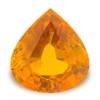Glittering Stones » Precious Stone Facts » Opal
Opal- “The Symbol of Hope, Happiness, and Truth”

Stone History:
The most prominent eminence of opal is its capability to refract and reflect specific wavelengths of light. The interplay of diverse wavelengths of light gives opal its exclusive visual appeal, and makes it one of the most sought-after gemstones in the world at all times.

Expensive opal has been a precious stone since Roman times. Opal was included among the noble gems and was ranked second only to emerald by the Romans. A beautiful opal called the orphans was set in the crown of the Holy Roman Emperor. It was described as “Though pure white snow flashed and sparked with the color of bright ruddy wine, and was overcome by this radiance." Opals are also set in the crown jewels of France.
For the most part, opal is more than 60 million years old and generally dates back to the Cretaceous period when dinosaurs roamed the earth. Most of the precious opal marketed in ancient times was obtained from occurrences in what is now Slovakia.
Description:
A solidified jelly has no crystal structure and contains up to 13% water. Precious opals are translucent to transparent and are eminent by a permutation of milky to pearly opalescence and a gorgeous play of many colors. These colors spark and change as a stone is viewed from different directions are caused by interference of light along minute cracks and other internal in homogeneities.
Opal is extensively used as a gemstone. Various forms of common opal are widely mined for use as abrasives, insulation media, fillers, and ceramic ingredients.

Color:
Opal is vitally colorless, but such material is rarely found. Scattered impurities generally instruct to opal a variety of dull body colors that range from the yellows and reds derived from iron oxides to black from manganese oxides and organic carbon. The milk ‘ness of many white and gray opals is attributable to an abundance of tiny gas-filled cavities in them. Precious opal reflects light with a play of brilliant colors across the visible spectrum, red being the most valued.

Varieties:
Fire Opal |
White Opal |
Black Opal |
 |
 |
 |
Fire opal is characterized by yellow, orange, or red body color. White and Fire opals are much more common.
White opal has light body colors.
Black opals, with a very dark gray or blue to black body color, are predominantly rare and extremely prized.
Opal as Birthstone:
Opal is considered to be the birthstone for the zodiac stone Libra (Balance): Sep 23- Oct 23. Opal is the anniversary gemstone for the 14th and 18th years of marriage.

Therapeutic ability
Opal has been described in medieval period as a cure for diseases of the eye.
Fire Opal:

Red corpuscle & blood disorders; depression; apathy; lethargy.
Black Opal

Reproductive organs; spleen & pancreas; filters red corpuscles & aids white corpuscles; bone marrow; depression, especially of sexual origin.
White Opal
Balances left and right brain hemispheres for neuron-disorders; stimulates white corpuscles.

Books on Opal
Opals by Fred Ward
In Opals, Fred Ward presents the history and lore of Opal. Chapters include History and Lore, Black Opal, Boulder Opal, Light Opal, Crystals and Fossils, Mexican Opal, Assembled Opals, Synthetics, and Stimulants, Buying and Caring for Opal, and Play-of-Color. Any reader with an interest in gemstones and opals will appreciate this lavishly illustrated book.

NOVEMBER BIRTHSTONE - CITRINE

COMMEMORATIVE EVENT - 13th Anniversary
KEYWORDS - Success, Abundance, Personal Power
ALSO KNOWN AS - Merchant's stone, Success stone
COLORS - Pale yellow to brown
OCCURRENCE - Brazil
COLOR ZONING - Tiger stripes or Zebra stripes


